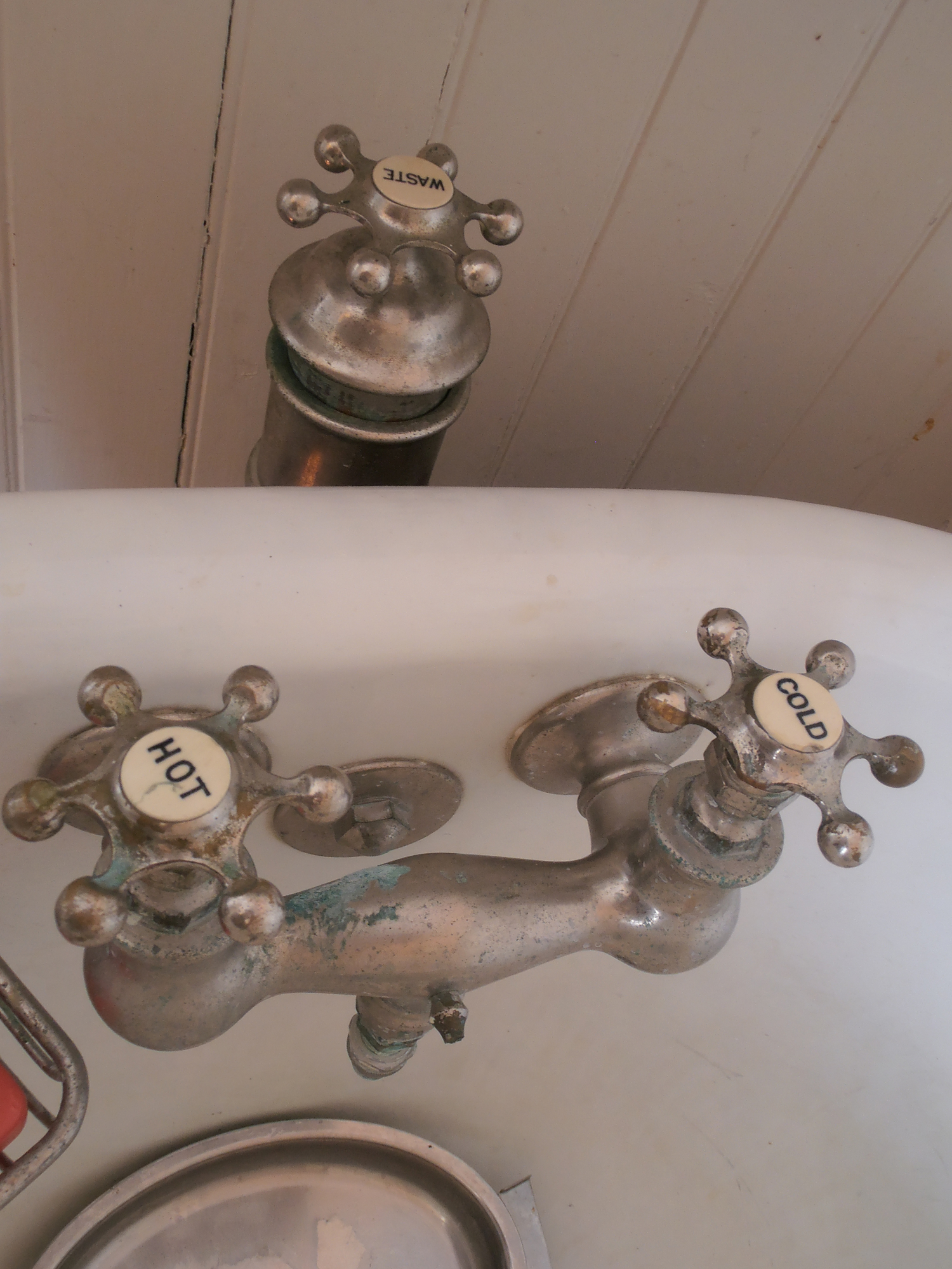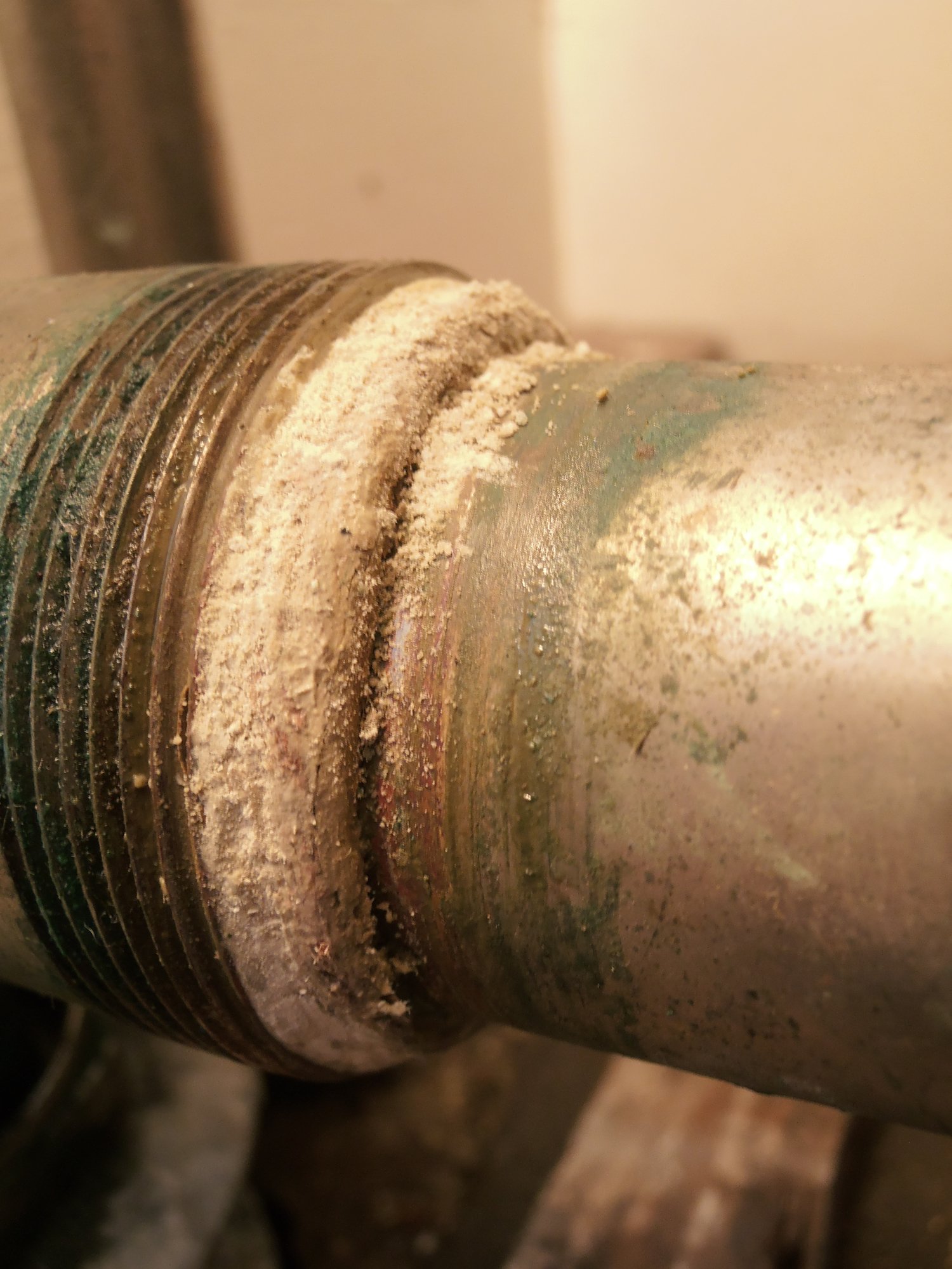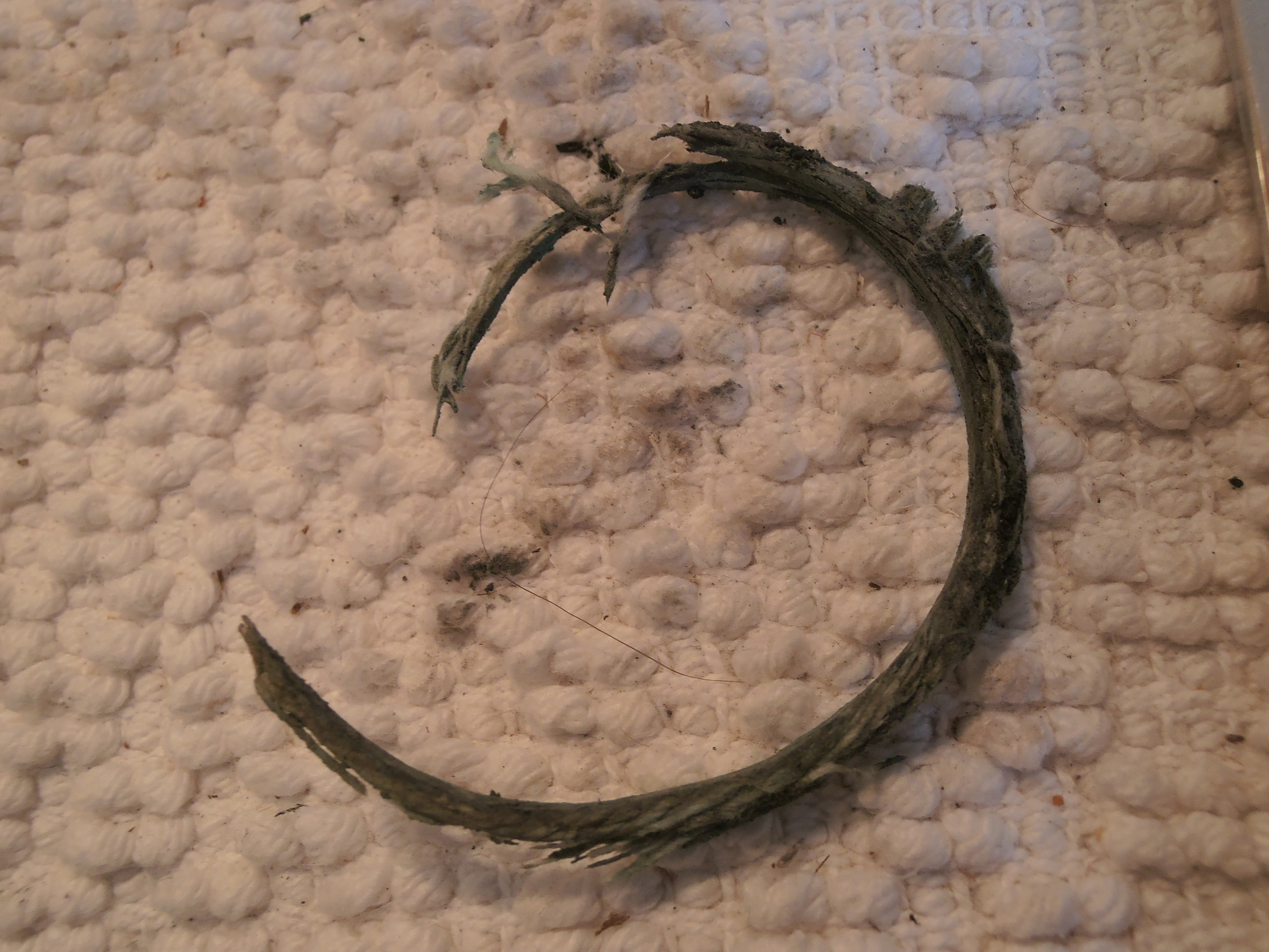Welcome! Here are the website rules, as well as some tips for using this forum.
Need to contact us? Visit https://heatinghelp.com/contact-us/.
Click here to Find a Contractor in your area.
If our community has helped you, please consider making a contribution to support this website. Thanks!
Antique plumbing - pics and questions
Options
We have a turn of the century house built just around 1900. One of the bathrooms has been remarkably untouched, and I'm trying to leave it that way; antique tub, sink and toilet. Unfortunately I couldn't find a plumber to repair the old fixtures. The reasonable statement any reasonable plumber makes is: just replace it!! So instead I do the repairs I can do.
In this case I have a clawfoot tub that I believe is original to when built, so it really is an antique. The main issue I am having is a leak from the drain, which has been dripping through into the kitchen. My short term fix was to stop using the tub, and that has allowed me to avoid looking at it. Now I finally have the time to get into this to figure out what is going on (my wife is visiting my daughter - it doesn't go well when she is around with ceilings and flooring cut away and water dripping and - you get the idea).
The joint that is leaking is the vertical connection at the nickel-coated brass fixture to 1-1/2" copper drain. The joint is clearly a compression joint, and when I loosened the joint there was almost no gasket material to keep the joint tight, just a couple turns of ancient faucet packing and lots of accumulated black gritty junk, but nothing to make a tight fitting. On the other hand, the horizontal compression joint with some sort of white packing has been leak free, and looks like I can tighten it back up without leak.
First question, does anyone recognize the material the horizontal joint is packed with? Since it is still working well, I would be happy to get some of that for the other joint.
Second question, if the horizontal joint material isn't available anymore, would any of the faucet packings types I pictured work, or is there a better way? I would prefer to use something that wouldn't require me to pull the whole fitting off, since that would destroy the horizontal joint too, and possibly require removing the drain inside the tub.










In this case I have a clawfoot tub that I believe is original to when built, so it really is an antique. The main issue I am having is a leak from the drain, which has been dripping through into the kitchen. My short term fix was to stop using the tub, and that has allowed me to avoid looking at it. Now I finally have the time to get into this to figure out what is going on (my wife is visiting my daughter - it doesn't go well when she is around with ceilings and flooring cut away and water dripping and - you get the idea).
The joint that is leaking is the vertical connection at the nickel-coated brass fixture to 1-1/2" copper drain. The joint is clearly a compression joint, and when I loosened the joint there was almost no gasket material to keep the joint tight, just a couple turns of ancient faucet packing and lots of accumulated black gritty junk, but nothing to make a tight fitting. On the other hand, the horizontal compression joint with some sort of white packing has been leak free, and looks like I can tighten it back up without leak.
First question, does anyone recognize the material the horizontal joint is packed with? Since it is still working well, I would be happy to get some of that for the other joint.
Second question, if the horizontal joint material isn't available anymore, would any of the faucet packings types I pictured work, or is there a better way? I would prefer to use something that wouldn't require me to pull the whole fitting off, since that would destroy the horizontal joint too, and possibly require removing the drain inside the tub.










0
Comments
-
I believe the white crusty one is a corroded brass compression ferrule. Those can be made up with the brass ferrule or with a rubber jam nut washer or even a nylon compression ferrule for pvc tubular waste. String packing should work fine as well, just make sure it is small enough diameter and add a little at a time so you don't put so much stress on the fitting trying to compress it that you crack it. I thing at least some of that assembly has been replaced at some point, unless the tube you think is copper coming out of the floor is actually brass that is wiped in to lead under the floor.0
-
BTW, that tub filler needs a backflow preventer added to is to be legal down under the water line of the tub like that under modern code.0
-
Oh, and if that is brass wiped in to lead, be very gentle with it, be very careful not to put and torque or lateral force on it or you could crack the lead pipe under the floor then you will have to open up the ceiling and replace until you get to something solid.0
-
I have several of those around here...
It's really not a problem. As has been mentioned, you will need a spool of the Teflon coated string -- I'd say either of the two on the right in your picture would work (the one on the left looks a bit thick). Then carefully clean as much of the crud as you can off the pipe, and wrap the string into the slip fitting. Use enough! It has to be stand a bit proud of the bottom of the fitting so it gets compressed. Press it by hand into the space between the pipe and the slip pipe. Then bring the nut up and tighten it -- but don't overdo it, as has been mentioned.
Technically @mattmia2 is correct on the code issue. However, in most jurisdictions unless you are changing the fixture, you are legal -- grandfathered in. So not to worry about that.
If you should find -- which you may -- that the faucet can't be repaired, Van Dykes Hardware (www.vandykes.com) has a staggering array of modern faucets which look like the old ones. Pricey, but worth it.Br. Jamie, osb
Building superintendent/caretaker, 7200 sq. ft. historic house museum with dependencies in New England3 -
Thank you both for your awesome replies! I used the stranded string-like spool (melard) because neither of the others seem to compress much. Hopefully I used enough of it; the initial test showed no leaks, but I know I'll have to watch it for a while and be prepared to re-do it if necessary. I was hesitant because I couldn't find any reference to using valve packing for this purpose so very glad to hear this is accepted practice.
It at least works well enough for me to move onto the faucet itself, which needs new gaskets, and possibly more.
BTW, Matt, you are correct about the pipe I called copper, which is soldered into a lead elbow which turns in a notch in the joist, so I definitely was worried about needing to replace that!
While talking about tubs, has anyone found any product that improves rust around the drain? The rest of the tub porcelain is perfect, and I have tried the white enamel paint touchup, but that doesn't last. Are there any other options?0 -
No that white enamel paint touchup is pretty useless. Not only does it not last, it's never quite the right colouir and almost looks worse.
Rust around the drain is a real problem. How bad a problem, however, depends on whether the porcelain is damaged, or just has rust on top of it. My approach to that has been (got a few of those, too...) to attack it in stages. Stage one being a sponge with an abrasive nylon mesh side. and Boraxo. Sometimes works. Sometimes doesn't. Then when it doesn't work and it looks as though maybe there's some scale in there as well, CLR cleaner. Which often doesn't do much either, but patience -- the stuff takes time to work. Then as a sort of last resort, Bar Keeper's Friend. By which time the area will be as clean as it's going to be...Br. Jamie, osb
Building superintendent/caretaker, 7200 sq. ft. historic house museum with dependencies in New England0 -
I have used something like zud to get the stain off(barkeeper's friend is similar, both contain oxalic acid). If the porcelain is actually chipped vs just stains from the spout dripping a little I have put a thin coat of clear silicone over the bare cast iron once i got the stain off.0
-
In addition to what @Jamie Hall said about choices of packing, you might look at Ace Hardware's #40209 graphite packing.
As supplied, it is very close to what you show as the original packing. Nice feature of this Ace 40209 packing is the strands can be unwound so you can use one strand at a time until the thickness is correct for this particular joint.Dennis Pataki. Former Service Manager and Heating Pump Product Manager for Nash Engineering Company. Phone: 1-888 853 9963
Website: www.nashjenningspumps.com
The first step in solving any problem is TO IDENTIFY THE PROBLEM.0 -
Glad you got it to work .... back in the day it was horse hair and hemp ..mixed with I don't know what. The modern hemp products w graphite still works best IMO .. most of the new fangled stuff is too thick.
In some cases there are modern reproductions available for some of those old setups. My new house is an addition to an old stone building that predates plumbing ... The bathroom was from around 1900 and I had the faucets and some other items re-chromed0 -
Thanks again, but it turns out I have one more leak problem before I can close up ceiling and floor and get to the white enamel (which is unfortunately more than just water staining). Remaining drip is in a threaded joint in the cold water supply, and not like I hoped due to the drain water from above. Very slow drip, about one drip every 10 hours, but I think I need to address it. Hard to see, but leak coming from right side of three way fitting in 1-1/4 or 1-1/2 in threaded brass pipe.
Should I try to tighten it first, or is this likely to cause more problems (I obviously really don't want to damage the three way fitting). Very limited access due to joist less than an inch away but I think I can get enough leverage. If I end up replacing, is there any reason to use the stub with cap as shown, or can I find a brass plug that would work as well. Pic shows the wrong size and steel not brass, but works for the pic.

0 -
Being so old and corroded from the leak is iffy. I'm not sure you have room to work and it will only be a temporary repair with the pipe being brass and that old. Does that riser feed anything besides the tub? Is the wall balloon framed such that you could fish new pex up to it?0
-
Beautiful old plumbing. When the valves eventually loosen up, finding a plumber to repair maybe a pain. That old drain handle is super old, only seen that a few times.@mattmia2 “Bring up to code” seriously? If the fireman sucks up 20 gallons of tub water I think everything will be ok.0
-
Don’t try and tighten, leak will worsen. Remove the stub/cap. Gotta be gentle with that old stuff. It sure looks simple to pull it apart but if you squeeze too hard you’re gonna egg the pipe and make it harder to remove. I’d try it with channel locks. If it doesn’t come easily then go get a small pipe wrench and do the “3 point contact”, to lessen the chance of egging the pipe.0
-
Just make sure it is not coming from top joint --- sometimes those small leaks can be sneaky.
What is the upper going to -- is that galvanized as well?
Concur -- go slow. They often do open up ...0 -
@GW, Can you please elaborate how to do the "3 point contact" when using a pipe wrench?Dennis Pataki. Former Service Manager and Heating Pump Product Manager for Nash Engineering Company. Phone: 1-888 853 9963
Website: www.nashjenningspumps.com
The first step in solving any problem is TO IDENTIFY THE PROBLEM.0 -
Yes, here’s a couple of examples, what is good and what is not good if your wrench is close to the fitting


1 -
@GW, Thanks for the clarification. I was thinking maybe there was some special V shaped jaw that I have never seen that afforded the 3 points of contact.
In searching around the net for how to use a pipe wrench, several sites specifically state to not have the pipe in contact with the movable jaw as you show in your lower pic. They state this can cause damage or even breakage of the movable jaw.Dennis Pataki. Former Service Manager and Heating Pump Product Manager for Nash Engineering Company. Phone: 1-888 853 9963
Website: www.nashjenningspumps.com
The first step in solving any problem is TO IDENTIFY THE PROBLEM.0 -
-
you'll shear the pipe off at the threads long before you will damage the jaw.0
-
I bought the threaded brass plug I needed (1" pipe). Pipe thread compound needed, or is just some teflon tape enough?0
-
yes.
it depends. in theory either should work but i'd try both in that case. dope on the threads, then tape, don't go overboard with the tape, 3 turns max because it can cause outward pressure on the fitting and split something that is marginal, maybe put a dab of dope on the threads inside the fitting.
everyone thinks their way is the best, most work most of the time
single strand ball wicking wound in to the base of the thread with dope and maybe tape can seal in difficult cases.0
Categories
- All Categories
- 87.3K THE MAIN WALL
- 3.2K A-C, Heat Pumps & Refrigeration
- 61 Biomass
- 427 Carbon Monoxide Awareness
- 119 Chimneys & Flues
- 2.1K Domestic Hot Water
- 5.8K Gas Heating
- 115 Geothermal
- 165 Indoor-Air Quality
- 3.7K Oil Heating
- 76 Pipe Deterioration
- 1K Plumbing
- 6.5K Radiant Heating
- 395 Solar
- 15.6K Strictly Steam
- 3.4K Thermostats and Controls
- 56 Water Quality
- 51 Industry Classes
- 50 Job Opportunities
- 18 Recall Announcements



